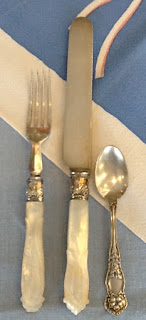Having the ladies over for dinner when the guys are on a week end fishing trip is my idea of a fun evening! For this dinner for six, our Spring menu was a first course of fried green tomatoes with dipping sauce and a main course of roast turkey breast with quinoa and asparagus pilaf. Turkey is thought of as a fall menu item, but I like it year round and think it's easier than roast chicken. Add flavor by rubbing butter and herb(s) of choice under the skin and then rub olive oil all over the outside and salt well.
The base cloth was a new solid blue, hem-stitched rectangle on our oval breakfast table. The second layer was a vintage 50's cloth in a floral and lace motif that almost looks likes aprons tied together.
For the first course I used a solid blue LuRay 8" plate. As you see in my front page photo, I have lots and lots of LuRay. Sometimes I mix colors and sometimes I use all of one color.
The crystal was Steuben glass wines that have a cranberry bowl and clear stem and for water vintage etched crystal tumblers.
The flatware was "Dresden Rose" silverplate by Reed and Barton. This is a good everyday pattern because it is not too plain nor too ornate and formal. It was first produced in 1953.
 The first course place setting included mercury glass salt cellars placed at the top of the plate for the fried green tomato dipping sauce.
The first course place setting included mercury glass salt cellars placed at the top of the plate for the fried green tomato dipping sauce.The salt and pepper set is silverplate with a red bakelite handle and base, circa 1940's. When one can buy sets this unique and with this much "personality," at equivalent prices, why buy new?!
For our centerpiece I used a faux orchid that was a gift from my son and daughter-in-law who live in Hawaii. It was handmade by an artisan there.
The dinner plate is "Furnivals Quail" in blue, first produced in 1913. Quail is a common pattern, made by several different companies and in different colors.
I used the 8" Quail plate, that is a little different pattern from the dinner plate, for dessert which was the strawberry short "cake" my Grandmother made me from leftover pie crust. She would bake pieces of rolled out pastry on a cookie sheet and break it into large pieces. Then she'd stack three pieces on a plate and ladle on juicy strawberries and homemade whipped cream. I still love this crunchy form of strawberry shortcake and do it on purpose, not just to use up leftover pie crust. 


With dessert I used antique Mother-of-Pearl knives and forks in dessert/salad size with a demitasse spoon in the Rogers & Bros pattern "Orange Blossom" made beginning in 1910, one of my favorites. Also, the Quail demitasse cup and saucer.
I used the credenza behind the breakfast table banquette as our buffet. I almost always serve buffet-style, rather than plated, so that guests can take the amounts they want.
Our first course fried green tomatoes were served on a round Quail platter with a vintage silverplate tomato server.
For the roast turkey breast I used the oval platter and a Mother-of-Pearl buffet fork.
And I served the quinoa and asparagus pilaf in a covered casserole in a different blue and white transferware pattern called "Venetian" by Henry Alcock that has gold highlights. Covered casseroles are a weakness of mine and are not that expensive when they are an odd piece, outside of a set. I used the matching buffet spoon to serve it.
Recipe for Frying Green Tomatoes
Soak 1/2" thick tomato slices in buttermilk for 15 minutes or so. Mix 3/4 cup cornmeal, 1/4 cup panko bread crumbs, 1 Tbsp baking soda, 1 tsp salt, and 1/2 tsp pepper. Dip tomato slices in flour, then egg wash, then the cornmeal mixture. Fry over med-high heat in skillet with 1/4" of peanut or grapeseed oil until golden. Drain on paper towels. Serve hot or at room temp.
Recipe for Dipping Sauce
1 clove garlic
1 large shallot, cut in half
1 heaping Tbsp dijon mustard
1 Tbsp red wine vinegar
4 stems of parsley (leaves & stems)
1/4 cup EVOO
1 cup buttermilk
1 tsp salt, or to taste
Fresh cracked pepper to taste
Put everything up to olive oil in a food processor and pulse to mince. With motor running, pour in oil to emulsify. Stir in buttermilk, salt and pepper.
Recipe for Quinoa and Asparagus Pilaf
2 Tbsp butter
1 small onion, diced
1 clove garlic, minced
1 cup quinoa, rinsed
1 1/4 cups water
1 bunch asparagus, tough ends broken off, and cut into 1" pieces diagonally
Salt and freshly ground pepper to taste
1 Tbsp lemon zest
Melt butter in a large saucepan over medium heat and saute onion for apx. 5 minutes or until translucent, but not browning. Add garlic and saute 1 minute more. Increase heat a little and add quinoa; saute 1 minute. Add water and bring to a boil. Reduce heat and simmer, covered, 20 minutes. Add asparagus, salt, pepper and zest. (If quinoa is fully dry, add a couple of Tbsp of water.) Steam with lid on 3 or 4 minutes, just until asparagus is crisp-tender. Serve hot or at room temp.

































































